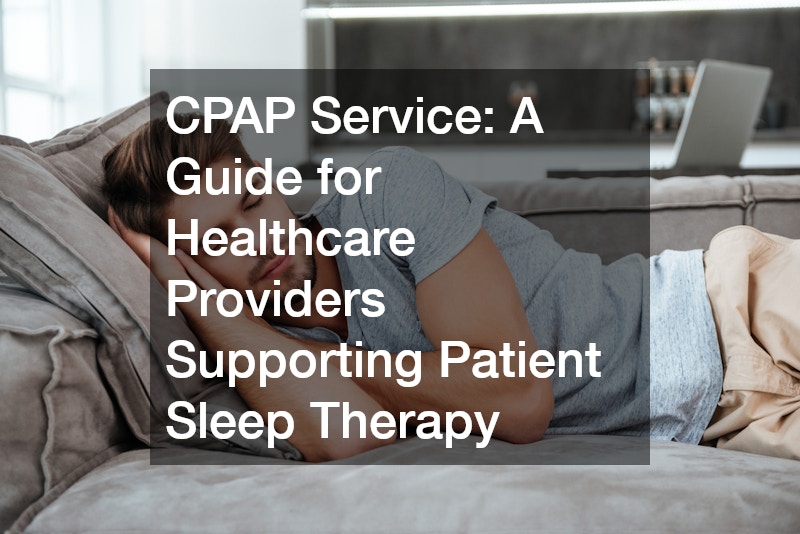
Continuous Positive Airway Pressure (CPAP) therapy plays a pivotal role in the realm of sleep healthcare. Healthcare providers are essential in guiding patients through CPAP therapy, ensuring they receive the full therapeutic benefits.
1. What is CPAP Therapy and How Does it Work?
CPAP service involves the use of a machine that maintains a constant flow of air pressure through a mask, worn over the nose, mouth, or both. The essential components include the CPAP machine itself, various types of masks, humidifiers, and settings to adjust air pressure to the patient’s needs.
The masks are available in three standard types: nasal, full-face, and nasal pillows, each catering to different comfort and breathing needs of the patient. Humidifiers attached to the CPAP machine help in reducing potential nasal dryness and irritation.
The settings for CPAP machines are often personalized to ensure optimal airflow based on the severity of the patient’s sleep apnea. Understanding these components allows healthcare providers to offer tailored advice and solutions to enhance patient comfort.
CPAP therapy effectively treats sleep apnea by providing a steady stream of pressurized air that prevents airway collapse during sleep. This mechanism alleviates common sleep apnea symptoms, such as loud snoring and interrupted breathing.
The consistent flow of air keeps the airway passages open, significantly reducing the number of apnea and hypopnea episodes throughout the night. Consequently, patients generally experience an improvement in sleep quality and daytime alertness.
This therapy has proven particularly crucial for patients with obstructive sleep apnea, offering a non-invasive solution that improves both immediate symptoms and long-term health outcomes. It is vital for healthcare providers to understand these mechanisms to adequately support and educate their patients.
2. How to Manage CPAP Therapy Compliance and Challenges?
Adherence to CPAP therapy is critical for its success, requiring healthcare providers to foster motivation and compliance among patients. Educating patients on the benefits of consistent CPAP use and the risks associated with non-compliance is a key strategy.
Behavioral interventions, such as routine follow-ups and positive reinforcement, can significantly boost patient adherence. Personalized care plans and addressing individual patient concerns also play a significant role in enhancing compliance.
Providers can leverage these strategies to ensure patients remain committed to their therapy, ultimately improving clinical outcomes. The use of data showing improvement in patients’ sleep patterns can serve as motivation for sustained CPAP usage.
Common issues patients may encounter with CPAP therapy include mask discomfort, air leaks, and nasal congestion. These challenges can hinder compliance and necessitate proactive troubleshooting by healthcare providers.
Adjusting the fit and type of mask can greatly reduce discomfort and minimize air leaks, enhancing the overall user experience. Additionally, ensuring that humidifiers are correctly adjusted can alleviate nasal congestion and dryness.
Healthcare providers should also educate patients on regular cleaning practices for CPAP equipment to prevent infections and improve air quality. Effective troubleshooting and support help maintain patient engagement with their treatment.
3. What are the Latest Advancements in CPAP Technology?
Recent advancements in CPAP technology have introduced more compact, portable machines, making therapy more accessible for active and traveling patients. These machines often incorporate features such as automatic pressure adjustments and quieter operation for increased comfort.
Adaptive servo-ventilation systems represent significant innovations, offering more tailored therapy by constantly monitoring and responding to the patient’s breathing patterns. This technology provides a more natural breathing experience and enhances patient comfort.
Such advancements position CPAP therapy as a versatile and patient-friendly option, increasing its acceptance and compliance. Healthcare providers must stay informed about these innovations to offer the best available advice and support to their patients.
The integration of data analytics and telemedicine with CPAP therapy is revolutionizing patient care by providing real-time insights into therapy compliance and effectiveness. Cloud-based systems allow healthcare providers to monitor patient data remotely, facilitating timely interventions.
Telemedicine platforms foster continuous patient engagement by enabling regular follow-ups and consultations without the need for in-person visits. This approach not only improves accessibility but also enhances the overall management of sleep disorders.
By leveraging these technological advancements, healthcare providers can deliver personalized and adaptive care, significantly improving patient outcomes in CPAP therapy. Access to comprehensive patient data and remote monitoring capabilities enhance the quality of care provided.
CPAP therapy is an essential component of sleep healthcare, offering significant benefits to patients with sleep apnea and related disorders. The role of healthcare providers is indispensable in guiding patients through the challenges and intricacies of CPAP therapy.
By understanding the equipment, promoting adherence, troubleshooting issues, and harnessing new technological advancements, providers can enhance patient experiences and outcomes. Ongoing education and support are paramount to the successful management of CPAP therapy.
Ultimately, a collaborative approach between healthcare providers and patients will ensure more effective and sustained sleep therapy, leading to better health and life quality for patients. As CPAP technology evolves, providers must remain proactive and informed to offer the best possible care solutions.


